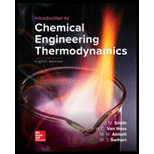
(a)
Interpretation:
The number of phase rule variables must be specified to fix the
Concept Introduction:
The numbers of phase rule variables must be specified to fix the thermodynamic state of each of the following systems by using following formula.
Answer to Problem 3.1P
The numbers of phase rule variables must be specified to fix the thermodynamic state is 2.
Explanation of Solution
Given:
Components =2 (Ethanol, Water)
Phases = (Liquid, Vapor)
Calculation:
A sealed flask containing a liquid ethanol-water mixture in equilibrium with its vapour.
From the above statement, Components =2 (Ethanol, Water)
Phases = (Liquid, Vapor)
(b)
Interpretation:
The number of phase rule variables must be specified to fix the thermodynamic state should be identified.
Concept Introduction:
The numbers of phase rule variables must be specified to fix the thermodynamic state of each of the following systems by using following formula.
Answer to Problem 3.1P
The numbers of phase rule variables must be specified to fix the thermodynamic state is 2.
Explanation of Solution
Given:
Components =3 (Ethanol, Water and nitrogen)
Phases = (Liquid, Vapor)
Calculation:
A sealed flask containing a liquid ethanol-water mixture in equilibrium with its vapour and nitrogen.
From the above statement, Components =3 (Ethanol, Water and nitrogen)
Phases = (Liquid, Vapor)
(c)
Interpretation:
The number of phase rule variables must be specified to fix the thermodynamic state should be identified.
Concept Introduction:
The numbers of phase rule variables must be specified to fix the thermodynamic state of each of the following systems by using following formula.
Answer to Problem 3.1P
The numbers of phase rule variables must be specified to fix the thermodynamic state is 2.
Explanation of Solution
Given:
Components = 3 (Ethanol, Toluene and water)
Phases = (Two Liquid, Vapor)
Calculation:
A sealed flask containing a liquid ethanol, toluene and water as two liquid phases plus vapour.
From the above statement, Components = 3 (Ethanol, Toluene and water)
Phases = (Two Liquid, Vapor)
Want to see more full solutions like this?
Chapter 3 Solutions
Introduction to Chemical Engineering Thermodynamics
 Introduction to Chemical Engineering Thermodynami...Chemical EngineeringISBN:9781259696527Author:J.M. Smith Termodinamica en ingenieria quimica, Hendrick C Van Ness, Michael Abbott, Mark SwihartPublisher:McGraw-Hill Education
Introduction to Chemical Engineering Thermodynami...Chemical EngineeringISBN:9781259696527Author:J.M. Smith Termodinamica en ingenieria quimica, Hendrick C Van Ness, Michael Abbott, Mark SwihartPublisher:McGraw-Hill Education Elementary Principles of Chemical Processes, Bind...Chemical EngineeringISBN:9781118431221Author:Richard M. Felder, Ronald W. Rousseau, Lisa G. BullardPublisher:WILEY
Elementary Principles of Chemical Processes, Bind...Chemical EngineeringISBN:9781118431221Author:Richard M. Felder, Ronald W. Rousseau, Lisa G. BullardPublisher:WILEY Elements of Chemical Reaction Engineering (5th Ed...Chemical EngineeringISBN:9780133887518Author:H. Scott FoglerPublisher:Prentice Hall
Elements of Chemical Reaction Engineering (5th Ed...Chemical EngineeringISBN:9780133887518Author:H. Scott FoglerPublisher:Prentice Hall
 Industrial Plastics: Theory and ApplicationsChemical EngineeringISBN:9781285061238Author:Lokensgard, ErikPublisher:Delmar Cengage Learning
Industrial Plastics: Theory and ApplicationsChemical EngineeringISBN:9781285061238Author:Lokensgard, ErikPublisher:Delmar Cengage Learning Unit Operations of Chemical EngineeringChemical EngineeringISBN:9780072848236Author:Warren McCabe, Julian C. Smith, Peter HarriottPublisher:McGraw-Hill Companies, The
Unit Operations of Chemical EngineeringChemical EngineeringISBN:9780072848236Author:Warren McCabe, Julian C. Smith, Peter HarriottPublisher:McGraw-Hill Companies, The





